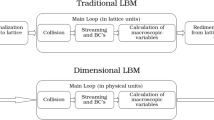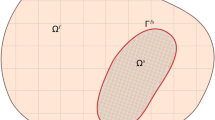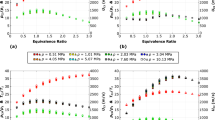Abstract
The Particle Finite Element Method (PFEM) is used to develop a model to study two-phase flow in fuel cell gas channels. First, the PFEM is used to develop the model of free and sessile droplets. The droplet model is then coupled to an Eulerian, fixed-grid, model for the airflow. The resulting coupled PFEM-Eulerian algorithm is used to study droplet oscillations in an air flow and droplet growth in a low-temperature fuel cell gas channel. Numerical results show good agreement with predicted frequencies of oscillation, contact angle, and deformation of injected droplets in gas channels. The PFEM-based approach provides a novel strategy to study droplet dynamics in fuel cells.










Similar content being viewed by others
Notes
Once again, linear pressure-velocity interpolations have been used for the space discretization while Backward Euler has been applied for the time integration.
For the examples solved in this work, the velocity of the droplet was not having considerable impact upon the airflow. Thus zero velocity can be used at \(\varGamma _\mathrm{I}\).
References
Akhtar N, Kerkhof PJAM (2011) Dynamic behavior of liquid water transport in a tapered channel of a proton exchange membrane fuel cell cathode. Int J Hydrog Energy 36(4):3076–3086
Bird R, Stewart W, Lightfoot E (2002) Transport phenomena, 2nd edn. Wiley, Hoboken
Bouwhuis W, Winkels KG, Peters IR, Brunet P, van der Meer D, Snoeijer JH (2013) Oscillating and star-shaped drops levitated by an airflow. Phys Rev E 88:023017
Brennen CE (2005) Fundamentals of multiphase flow, 1st edn. Cambridge University Press, Cambridge
Carton J, Lawlor V, Olabi A, Hochenauer C, Zauner G (2012) Water droplet accumulation and motion in PEM (Proton Exchange Membrane) fuel cell mini-channels. Energy 39:63–73
Chen K, Hickner M, Noble D (2005) Simplified models for predicting the onset of liquid water droplet instability at the gas diffusion layer/gas flow channel interface. Int J Energy Res 29(12):1113–1132
Cho SC, Wang Y, Chen K (2012) Droplet dynamics in a polymer electrolyte fuel cell gas flow channel: forces, deformation, and detachment. I: theoretical and numerical analyses. J Power Sources 206:119–128
Choi J, Son G (2009) Numerical study of droplet dynamics in a PEMFC gas channel with multiple pores. J Mech Sci Technol 23(7):1765–1772
Chorin AJ (1967) A numerical method for solving incompressible viscous problems. J Comput Phys 2:12–26
Codina R (2001) A stabilized finite element method for generalized stationary incompressible flows. Comput Methods Appl Mech Eng 190 (20–21):2681–2706. http://www.sciencedirect.com/science/article/pii/S0045782500002607 doi:10.1016/S0045-7825(00)00260-7
Codina R (2001) Pressure stability in fractional step finite element method for incompressible flows. J Comput Phys 170:112–140
Crowe CT (2006) Multiphase flow handbook, 1st edn. Taylor & Francis, Abingdon
Feng Y, Idelsohn S, Nigro N, Gimenez J, Rossi R, Marti J (2013) A fast and accurate method to solve the incompressible Navier–Stokes equations. Eng Comput 30(2):197–222
Ferreira RB, Falcão DS, Oliveira VB, Pinto AMFR (2015) Numerical simulations of two-phase flow in proton exchange membrane fuel cells using the volume of fluid method - A review. J Power Sources 277:329–342
Gerstenberger A, Wall W (2008) An extended finite element/Lagrange multiplier based approach for fluid-structure interaction. Comput Methods Appl Mech Eng 197:1699–1714
Gerstenberger A, Wall W (2010) An embedded Dirichlet formulation for 3D continua. Int J Numer Methods Eng 82(5):537–563
Gopala V, van Wachem G (2008) Volume of fluid methods for immiscible-fluid and free-surface flows. Chem Eng J 141:204–221
Guermond J, Minev P, Shen J (2006) An overview of projection methods for incompressible flows. Comput Methods Appl Mech Eng 195:6011–6045
Idelsohn SR, Oñate E, Pin FD (2004) The particle finite element method: a powerful tool to solve incompressible flows with free-surfaces and breaking waves. Int J Numer Methods Eng 61(7):964–989
Israelachvili J (2011) Intermolecular and surface forces, 3rd edn. Elsevier, Waltham
Jarauta A, Ryzhakov PB, Secanell M, Waghmare PR, Pons-Prats J (2015) Numerical study of droplet dynamics in a Proton Exchange Fuel Cell gas channel using an embedded formulation. J Power Sources (submitted)
Jarauta A, Secanell M, Pons-Prats J, Ryzhakov PB, Idelsohn SR, Oñate E (2015) A semi-analytical model for droplet dynamics on the GDL surface of a PEFC electrode. Int J Hydrog Energy 40:5375–5383
Kamran K, Rossi R, Onate E, Idelsohn S (2013) A compressible Lagrangian framework for the simulation of the underwater implosion of large air bubbles. Comput Methods Appl Mech Eng 255:210–225
Kandlikar S, Lu Z, Domigan W, White A, Benedict M (2009) Measurement of flow maldistribution in parallel channels and its application to ex-situ and in-situ experiments in pemfc water management studies. Int J Heat Mass Transf 52(7):1741–1752
Küttler U, Wall W (2009) Vector extrapolation for strong coupling fluid-structure interaction solvers. J Appl Mech 76(2):021–205
Lamb H (1916) Hydrodynamics, 4th edn. Cambridge University Press, Cambridge. https://books.google.es/books?id=d_AoAAAAYAAJ
Marti J, Ryzhakov P, Idelsohn S, Oñate E (2012) Combined Eulerian-PFEM approach for analysis of polymers in fire situations. Int J Numer Methods Eng 92:782–801
Mier-Torrecilla, M (2010) Numerical simulation of multi-fluid flows with the Particle Finite Element Method. Ph.D. thesis, Universitat Politécnica de Catalunya
Oñate E, Idelsohn S, del Pin F, Aubry R (2004) The particle finite element method: an overview. Int J Comput Methods 1:267–307
Ryzhakov P, Oñate E, Rossi R, Idelsohn S (2010) Lagrangian FE methods for coupled problems in fluid mechanics. CIMNE. ISBN: 978-84-96736-97-9
Ryzhakov PB, Jarauta A (2015) An embedded approach for immiscible multi-fluid problems. Int J Numer Methods Fluids. doi:10.1002/fld.4190
Sussman M, Ohta M (2009) A stable and efficient method for treating surface tension in incompressible two-phase flow. SIAM J Sci Comput 31:2447–2471
Temam R (1969) Sur l’approximation de la solution des equations de Navier-Stokes par la methode des pase fractionaires. Arch Ration Mech Anal 32:135–153
Theodorakakos A, Ous T, Gavaises M, Nouri J, Nikolopoulos N, Yanagihara H (2006) Dynamics of water droplets detached from porous surfaces of relevance to PEM fuel cells. J Colloid Interface Sci 300:673–687
Weber AZ, Borup RL, Darling RM, Das PK, Dursch TJ, Gu W, Harvey D, Kusoglu A, Litster S, Mench MM, Mukundan R, Owejan JP, Pharoah JG, Secanell M, Zenyuk IV (2014) A critical review of modeling transport phenomena in Polymer-Electrolyte fuel cells. J Electrochem Soc 161(12):F1254–F1299
Wörner M (2012) Numerical modeling of multiphase flows in microfluidics and micro process engineering: a review of methods and applications. Microfluid Nanofluid 12:841–886
Wu T, Djilali N (2012) Experimental investigation of water droplet emergence in a model polymer electrolyte membrane fuel cell microchannel. J Power Sources 208:248–256
Zhu X, Sui P, Djilali N (2008) Three-dimensional numerical simulations of water droplet dynamics in a PEMFC gas channel. J Power Sources 181:101–115
Author information
Authors and Affiliations
Corresponding author
Ethics declarations
Funding
This work was supported under the auspices of the FPDI-2013-18471 and BES-2011-047702 grants of the Spanish Ministerio de Economia y Competitividad as well as partially funded by the COMETAD project of the National RTD Plan (ref. MAT2014-60435-C2-1-R) of the mentioned ministry.
Conflict of interest
The authors declare that they have no conflict of interest.
Rights and permissions
About this article
Cite this article
Ryzhakov, P.B., Jarauta, A., Secanell, M. et al. On the application of the PFEM to droplet dynamics modeling in fuel cells. Comp. Part. Mech. 4, 285–295 (2017). https://doi.org/10.1007/s40571-016-0112-9
Received:
Revised:
Accepted:
Published:
Issue Date:
DOI: https://doi.org/10.1007/s40571-016-0112-9




